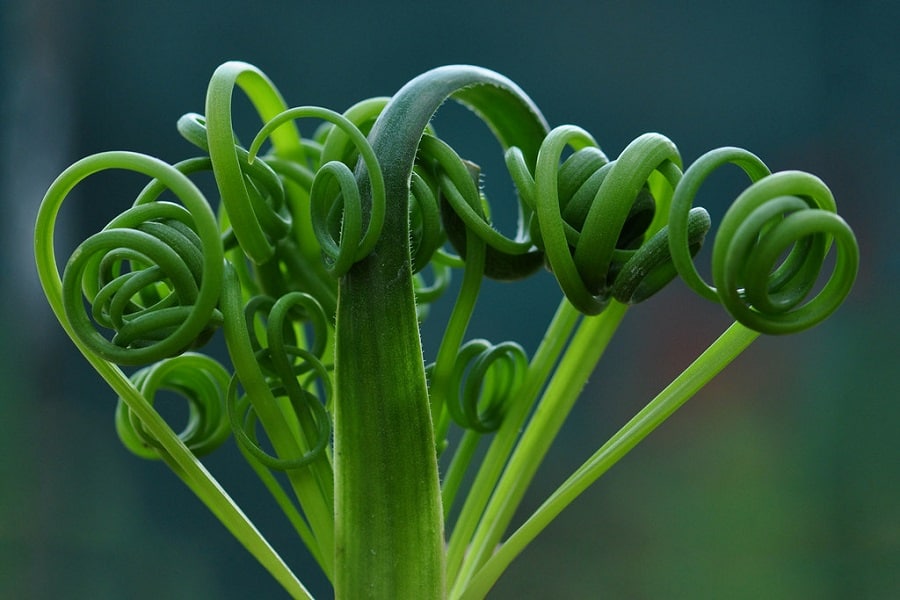Spiral Grass Succulent (Albuca Spiralis) 101: Care and Propagation Simplified
Are you fascinated by unique and enchanting plants? If so, then let me introduce you to the Albuca Spiralis, also known as the Corkscrew Albuca or Frizzle Sizzle. This extraordinary flowering plant is native to the beautiful Northern and Western regions of South Africa. It features long and slender leaves with whimsical corkscrew tips, lending a touch of magic to any garden.
In this comprehensive guide, we will dive into the world of the Frizzle Sizzle and explore everything you need to know about caring for this mesmerizing spiral grass succulent. So, let’s embark on this botanical journey together and discover the secrets of this extraordinary plant!

Contents
Spiral Grass Succulent Info
The spiral grass succulent, also known as the Frizzle Sizzle, belongs to the Asparagaceae family. It grows to a height of about 8 inches and has dark green leaves that spiral out from the bulb. These leaves have glandular hairs on the tips. During late winter to spring, the plant produces around 10-20 yellowish-green flowers that have a sweet vanilla scent.
Check this out:
1,000 Types of Succulents
How to Care for the Spiral Grass Succulent
Light
The spiral grass succulent needs plenty of light to thrive. It can do well in partial sun as long as it gets 5 to 7 hours of sunlight. However, full sun is even better. If the plant doesn’t receive enough light, the leaves may become wavy and long, but they won’t curl. Avoid placing the plant in direct sunlight or extremely hot temperatures, as it can get burned. If growing indoors, consider using a grow light or placing the plant in a location that receives natural light.

Watering
Proper watering is essential for the Frizzle Sizzle plant. Avoid overwatering, as excessive moisture can make the leaves soft or floppy and prevent the spirals from forming. During the summer and fall, water the plant once every 2-3 weeks, making sure the soil is just damp. Allow the soil to dry out between waterings.
In cooler weather, increase the frequency of watering, keeping the soil moist but not soggy. Avoid letting the container sit in water, as this can cause bulb rot. If the leaves become soft, wilted, yellow, or floppy, you’re likely overwatering the plant. Reduce watering until the soil dries out before watering again. Underwatering can cause drooping leaves, dry tips, and stunted growth.
Soil

The spiral grass succulent thrives in sandy soil that allows for good airflow while retaining enough water. You can use a succulent and cactus mix or create your own soil blend by mixing regular potting soil with mineral grit like pumice, coarse sand, or perlite. Regular pH levels in the soil are suitable for the plant’s growth.
Fertilizing
Fertilize the spiral grass succulent in late fall before its active growing season and again in spring when flower stalks start to form. Use liquid fertilizer designed for this type of succulent. Before applying fertilizer, make sure to water the plant well the day before to ensure it’s fully hydrated. Apply the fertilizer to the soil, not the plant, and let any excess liquid drain through the soil. Stop fertilizing when the plant enters dormancy in late spring.
Climate
The spiral grass succulent thrives in U.S. Hardiness zones 8 to 11, with optimal temperatures ranging from 60°F to 75°F. It prefers slightly warmer temperatures, but during intense summer sunlight, it’s best to move the plant indoors to prevent burning. It does well in winter but is not frost-hardy, so protect it from freezing temperatures. Cooler temperatures are necessary for the plant to produce viable seeds.
Pests and Diseases
The spiral grass succulent is usually pest-free but may occasionally face spider mite problems in the soil during hotter months. It is generally disease-free, but overwatering can cause bulb rot and fungal growth. Avoid overwatering and use sandy soil to promote quick drainage and prevent issues.
Albuca spiralis Propagation
The Albuca Spiralis succulent can be propagated through bulbs, seeds, or division. Each method has its own unique process and considerations. Let’s explore these propagation techniques in more detail.
Propagation Through Bulbs
To propagate the spiral grass succulent using bulbs, you’ll need to follow a few simple steps. Here’s how:
- Find a healthy, mature plant: Look for a well-established Frizzle Sizzle plant with robust bulbs and healthy roots. These bulbs will serve as the starting point for new plants.
- Prepare the bulbs: Carefully separate the bulbs from the parent plant, ensuring that each bulb has its own set of roots intact. Gently remove any excess soil from the bulbs, but avoid damaging the delicate roots.
- Choose the planting location: Select an appropriate location for replanting the bulbs. It should provide adequate sunlight and well-draining soil.
- Replant the bulbs: Dig small holes in the soil at a depth that allows the bulbs to sit comfortably, around 2 inches deep. Place each bulb in a separate hole, making sure the roots are properly positioned, and cover them with soil. Press the soil gently to secure the bulbs in place.
- Water the newly planted bulbs: After replanting, water the bulbs thoroughly to settle the soil and provide essential moisture. Ensure that the soil is evenly moist, but avoid overwatering.
Propagation Through Seeds
If you choose to propagate the spiral grass succulent using seeds, follow these steps:
- Collect the seeds: Allow the Frizzle Sizzle plant to flower and produce seed pods. Once the seed pods have matured, carefully collect the seeds by gently shaking or tapping the pods into a container.
- Prepare the planting medium: Create a suitable planting medium for the seeds. This can be a succulent and cactus mix or a well-draining soil blend. Moisture retention is crucial, so ensure the soil provides proper airflow.
- Plant the seeds: Place the seeds on the surface of the prepared soil mixture. Sprinkle a thin layer of soil or sand over the seeds to lightly cover them. Mist the seeds with water to keep them damp.
- Provide the right environment: Place the container with the seeds in a location that receives ample sunlight. Ensure the temperature remains consistently warm, as this promotes germination. Mist the seeds regularly to maintain moisture levels.
- Monitor and care for the seedlings: Keep a close eye on the planted seeds and be patient, as germination may take several weeks. Once the seedlings begin to grow, continue to provide adequate sunlight and water them sparingly to avoid overwatering.
Propagation Through Division
To propagate using division, follow these steps:
- Identify suitable clusters: Locate a mature Frizzle Sizzle plant with a cluster of healthy, mature bulbs. These clusters usually consist of several bulbs connected by a network of roots.
- Separate the clusters: Gently separate the individual clusters of bulbs, taking care not to damage the roots or bulbs. You may need to use your hands or a clean, sharp knife for this process.
- Replant the divided clusters: Prepare a planting location with well-draining soil and proper sunlight. Dig small holes in the soil, spacing them adequately to accommodate each divided cluster. Place each cluster in a separate hole, ensuring the roots are adequately covered with soil.
- Water the newly planted clusters: After replanting, water the clusters thoroughly while being mindful not to oversaturate the soil. Aim for even moisture distribution without waterlogging.
By following these propagation methods, you can expand your collection of spiral grass succulents and share their unique beauty with others. Keep in mind that propagation requires patience and attentive care, but the joy of watching new plants flourish is incredibly rewarding.
FAQs
Should I let my Frizzle Sizzle flower?
Allowing your Frizzle Sizzle plant to produce flower stalks may cause the leaves to dry or turn brown. To prevent this, it’s better to remove the flower stalks as soon as they appear if you don’t want it to happen to your succulents.
Should I cut back my frizzle sizzle?
The Frizzle Sizzle plant doesn’t require regular pruning or cutting back. Only remove the flower stalks to allow the leaves to curl properly. Additionally, during dormancy, pruning may be necessary to remove sunburned or yellow leaves.
